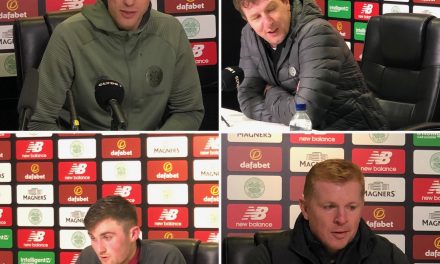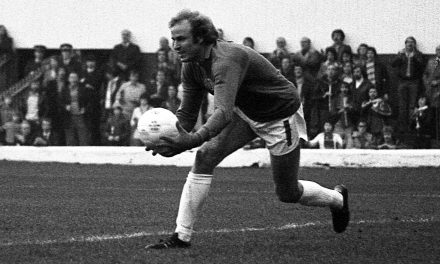In early 1980 the Celtic View was a modest 8 page newspaper publication. One of the highlights of reading it each week was to check the results and progress of the Celtic reserve team. At this time Frank Connor was the reserve coach and it became apparent from his weekly reports that there were several excellent prospects in his successful reserve side who were now said to be on the fringes of the first team. These included Pat Bonner, Willie McStay, Mark Reid, Jim Duffy, John Weir, Danny Crainie and John Halpin, who all went on to have excellent careers in the game. But the one said to be the brightest prospect of them all was Charlie Nicholas.
Nicholas was a sensation at reserve level who seemed to be scoring in every game and he was promoted to the first team to the subs’ bench for a few league games at the close of the 1979-80 season, although he never got to appear. Earlier that season he played in two Glasgow Cup ties, which were essentially reserve games, and he had impressed in scoring on both occasions as Celtic defeated Queens Park 3-1 and Clyde 3-0.
In the summer of 1980 it was expected that Nicholas and some of his reserve colleagues would now make the big breakthrough into the senior eleven. Although clearly a talent, he had a number of experienced players to displace to get into that side with Frank McGarvey, George McCluskey, Johnny Doyle and Bobby Lennox all in the queue for a place in the side ahead of him. As fate would have it Lennox suffered serious injury that summer and had to eventually retire and Doyle also picked up an injury which laid him low for some time.
On 16 August 1980 Charlie made his league debut as a sub for George McCluskey in a 3-0 win against Kilmarnock at Rugby Park and impressed all observers by showing great awareness and hitting the post late on. However, his big chance came two weeks later at Parkhead against Stirling Albion in the League Cup. In a two legged affair, Celtic had sensationally lost 1-0 at Annfield in the first game and in the second leg they were minutes from going out the competition, in disastrous fashion, until Tommy Burns scored a dramatic equaliser. In extra time Nicholas came on, again for McCluskey, and scored twice as Celtic romped home as eventual 6-1 winners. Charlie was now not to look back.
On 3 September Celtic travelled to Hungary to play the second leg of their European Cup Winners Cup tie against the quaintly named Diosgyeori Miskolc. The Hungarians had knocked Dundee United out of the previous year’s UEFA cup and were expected to be a handful, however Celtic had destroyed them in the first leg by 6-0 with Frank McGarvey rattling in a hat trick. Charlie hadn’t played in the first leg but the goals against Stirling saw him paired with McGarvey in the Celtic attack for the first time and he scored yet again in a disappointing 2-1 defeat although the aggregate score was 7-2 in Celtic’s favour.
On 6 September Billy McNeill had a big decision to make between Nicholas and McCluskey to partner McGarvey against Partick Thistle in a league game at Celtic Park. He opted to retain Charlie and he was not to be disappointed. Nicholas scored twice, but what was now apparent was that he was not only a goal scorer but it was also the quality of his finishing that was hugely impressive. Thistle had a decent team at that time with Alan Rough, Scotland’s Word Cup goalkeeper, between the posts. Yet they could not prevent Charlie scoring two exquisite goals, the first after he had teed the ball up and hammered the ball home, and then he bettered that with his second, feinting past a Thistle defender and swerving a shot high past Rough, who could only stand motionless. Celtic won 4-1 in the end.
Charlie Nicholas had now burst on the Scottish footballing scene and become a household name. It was not just the volume of goals bit his all round play that was to be admired. He had quick feet, had a great habit of turning with his back to goal, had superb control and possessed a powerful shot with either foot. The partnership between the young Charlie and the experienced Frank McGarvey had now began to blossom and both players’ styles were totally compatible. McGarvey’s busy habit of buzzing around defenders and his unorthodox playing style was the perfect foil for Charlie’s technique and clever movement off the ball. Both were individually talented and both were capable of being involved in the build-up as well as being prolific goal scorers. It was clear that they were on the same level and they formed an outstanding strike partnership
Around this period Charlie was now becoming a minor celebrity within the city. He sported a trendy hair style and his boyish looks and distinctive flowing locks gave him an army of female admirers. He was certainly photogenic and sported the latest fashion trends. The Evening Times newspaper did a double page photo shot with Charlie in which he modelled the latest stylish clothing donated by the fashionable, expensive, gents’ outfitters, Ger-ralds who were based in Glasgow city centre. Fast approaching his 19th birthday, Charlie was said to frequent the bright lights of Glasgow each weekend attending what was traditionally known as ‘the dancing’ where there was no shortage of attention from impressionable teenage girls. Gallus, that wonderful word from the Glaswegian dictionary, could have been invented for Charlie. Confident, talented and full of bravado – on and off the park.
On the field of play things continued to improve. The media had a number of nicknames for him, Champagne Charlie, Charles de Goal, and maybe the most popular one, said to have been coined by the late Jimmy Sanderson, The Cannonball Kid. Charlie scored a flashing header against Hearts at Tynecastle and followed this up with two more against continental opposition, this time the Rumanians of Politechnica Timosoara. Although Celtic won 2-1 they should have won by much more and the late away goal they conceded proved costly when they lost 1-0 in the second leg and missed out on a highly lucrative tie against West Ham United in the next round.
The month of October saw Charlie score even more goals, against Partick, Dundee United, Morton and Kilmarnock. Between 30 August and 25 October the young Celtic striker had netted a hugely impressive 16 goals in just 16 appearances. It was difficult to remember any other young player who had made such an immediate impact whilst playing in the Scottish game. Only Kenny Dalglish, ten years previously, had there been another player who had made such an outstanding impression at a comparatively young age.
On All Saints day 1980, Celtic travelled to Ibrox for what was to be a watershed game in Charlie’s fledgling career. Celtic lost 3-0 to Rangers on a miserable afternoon when Billy McNeil lost patience with his ineffective strikers and pulled Nicholas and McGarvey off long before the end. This was Charlie’s first introduction to the Glasgow derby and he had found the occasion too much for him. However, this was a minor set back and he proved to be a quick learner, Any doubts over his temperament were dispelled in the final two derby games when Celtic won 3-1 at Parkhead on a day of raw passion (Charlie scoring twice), then he followed that up in April by scoring the winner at Ibrox in a 1-0 win.
Even after all these years it’s easy to recollect what an impression Charlie Nicholas made in those early Celtic appearances. It was breath taking the way he absolutely exploded on to the scene and no other young Celtic player has come near this instant success. It would actually be nice to think that another young Celt could emulate him in the near future. Only time will tell.





